In this article, we’ll look at how to use join on more than two tables and aggregate the result using the function STRING_AGG() in Microsoft SQL Server.
If you don’t know about Microsoft SQL Server, I’ll briefly explain to you what it is😃. Let's get started.
What is Microsoft SQL Server?
Microsoft SQL Server is a Relational Database Management System that revolutionized how businesses handle data. It helps you store and manage data.
If you’re familiar with other relational database management systems such as MySQL or PostgreSQL, then picking up Microsoft SQL Server should be pretty easy.
I’m running on the default instance of SQL server.
Now, let’s consider a problem.
The Problem: How to Get Employee Details and Projects
Let’s say we have three tables, namely Employee, Project, and EmployeeProject. The below image is the relational database design:
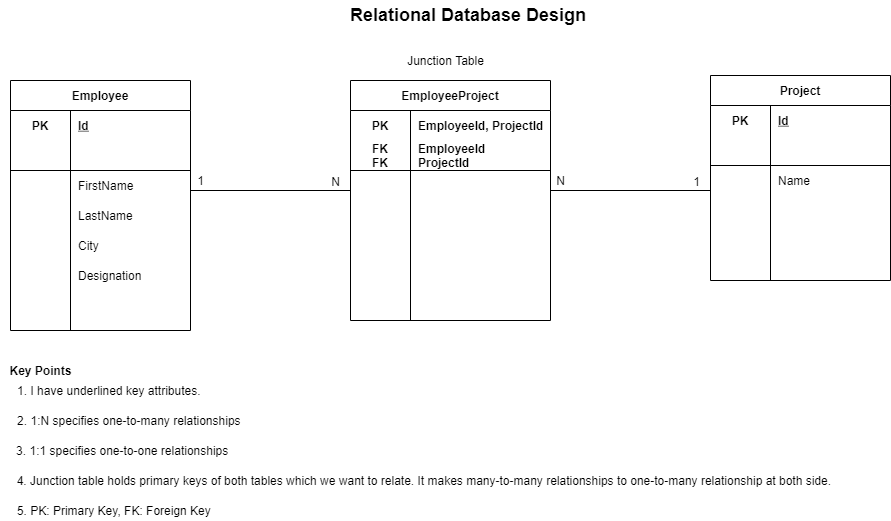
The problem is to get all the employee details and their corresponding projects.
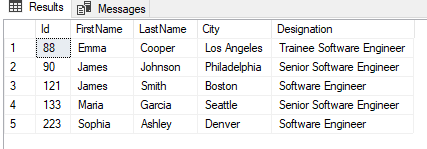
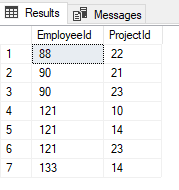
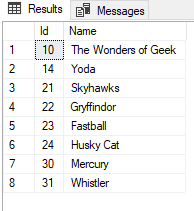
Things to consider: not all the employees from table Employee mapped with table EmployeeProject and not all the projects in table Project mapped with table EmployeeProject .
Our main goal is to retrieve all the employee details from table Employee whether they are mapped with EmployeeProject or not.
We can try to solve this problem by using joins. As you can see, we have to join three tables in order to solve this problem. First, we need to join tables Employee and EmployeeProject . Then we'll join the resulting table with Project .
Let’s go through some scenarios to solve this problem.
Solution #1: Use Inner Join
Let’s go with INNER JOIN everywhere!
SELECT e.Id, e.FirstName, e.LastName, e.Designation, e.City, ep.ProjectId
FROM Employee AS e INNER JOIN EmployeeProject AS ep
ON e.Id = ep.EmployeeIdThis will give us:
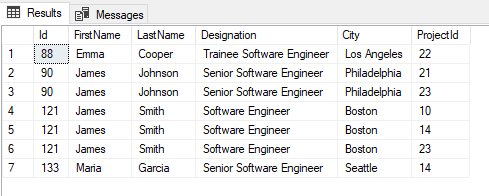
Let’s think of the above table as Employee-EmployeeProject . It contains all the employee details as well as their corresponding project ids.
With the help of Employee-EmployeeProject, we’ll be able to access the Project table. Let’s do that:
SELECT abc.FirstName, abc.LastName, abc.City, abc.Designation, p.Name AS Project FROM Project AS p
INNER JOIN
(SELECT e.Id, e.FirstName, e.LastName, e.Designation, e.City, ep.ProjectId
FROM Employee AS e INNER JOIN EmployeeProject AS ep
ON e.Id = ep.EmployeeId) AS abc
ON p.Id = abc.ProjectIdOutput:
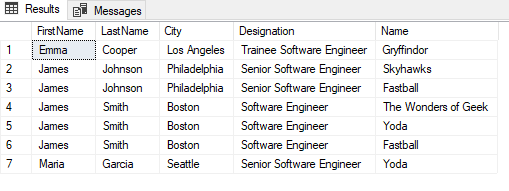
Great! 😃 Now we are able to retrieve employee details as well as their corresponding projects. But our main goal is missing (that is, to get all the employee details) as we’re missing Sophia Ashley’s details.
Scenario 1 worked, but we didn't accomplish our goal. 😆
Solution #2: Use Left Join
Let’s get all the details from employees whether they are mapped with EmployeeProject or not (our goal) by using LEFT JOIN with Employee table:
SELECT e.Id, e.FirstName, e.LastName, e.Designation, e.City, ep.ProjectId FROM Employee AS e LEFT JOIN EmployeeProject AS ep ON e.Id = ep.EmployeeIdThis query will give us:
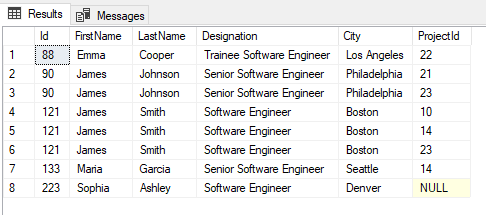
As you can see from the above figure, we are able to retrieve Sophia Ashley’s details since we’re using LEFT JOIN on Employee table with EmployeeProject table.
Let’s think of the above table as Employee-EmployeeProject . It contains all the employee details as well as their corresponding project ids (including NULL for when it doesn’t contain any ProjectId value).
Similar to scenario 1, now we can access project names since we know ProjectId . Remember, our goal is to retrieve all the employee details whether they have a project or not.
To ensure that, we’ll need to retrieve all the values from Employee-EmployeeProject when joining with Project table:
SELECT abc.FirstName, abc.LastName, abc.City, abc.Designation, p.Name AS Project FROM Project AS p RIGHT JOIN (SELECT e.Id, e.FirstName, e.LastName, e.Designation, e.City, ep.ProjectId FROM Employee AS e LEFT JOIN EmployeeProject AS ep ON e.Id = ep.EmployeeId) AS abc ON p.Id = abc.ProjectId
Great work! We achieved our goal. 😃
This is good stuff. But it would be great if we were able to group these rows and return one row per employee. This is our new wish! 😉
This leads us to question how we can group these results. We can group these rows by using GROUP BY .
So, we’ll GROUP BY the results in rows by FirstName :
SELECT abc.FirstName, abc.LastName, abc.City, abc.Designation, p.Name AS Project FROM Project AS p RIGHT JOIN (SELECT e.Id, e.FirstName, e.LastName, e.Designation, e.City, ep.ProjectId FROM Employee AS e LEFT JOIN EmployeeProject AS ep ON e.Id = ep.EmployeeId) AS abc ON p.Id = abc.ProjectId GROUP BY abc.FirstNameAnd the output is:

What happened?
It says column LastName is invalid in the select list because it is not contained in either an aggregate function or the GROUP BY clause. This error is applicable to all the remaining columns in the selected list except FirstName .
When we try to select values of FirstName and group by FirstName, it means that we’re going to group all the rows based on FirstName only and select the FirstName column. For example, let’s select only FirstName and group by FirstName:
SELECT abc.FirstName FROM Project AS p RIGHT JOIN
(SELECT e.Id, e.FirstName, e.LastName, e.Designation, e.City, ep.ProjectId FROM Employee AS e LEFT JOIN EmployeeProject AS ep ON e.Id = ep.EmployeeId) AS abc ON p.Id = abc.ProjectId GROUP BY abc.FirstName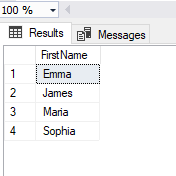
As you can see in figure 10, we’ve grouped all the rows by FirstName . Here, there’s no ambiguity.
Now, let’s select FirstName, LastName, and group all the rows by FirstName :
SELECT abc.FirstName, abc.LastName FROM Project AS p RIGHT JOIN (SELECT e.Id, e.FirstName, e.LastName, e.Designation, e.City, ep.ProjectId FROM Employee AS e LEFT JOIN EmployeeProject AS ep ON e.Id = ep.EmployeeId) AS abc ON p.Id = abc.ProjectId GROUP BY abc.FirstName
If we check out what the values of LastName are in Figure 8, we can see that we have two employees with the same FirstName but different LastName: James Johnson and James Smith.
So, when we try to group all the rows by FirstName and select the values of FirstName and LastName, it leads us to an ambiguity state.
Imagine that MSSQL asks us, “You’re selecting FirstName ,LastName and trying to group all the rows by FirstName. But the FirstName James has two different LastNames, Johnson and Smith. When selecting James’s last name, what should his LastName be? Johnson? Smith? or both?” There's ambiguity in MSSQL regarding which one to select.
To solve this FirstName and LastName issue, we can either (option 1) group all the rows by both FirstName and LastName or (option 2) enclose LastName into an aggregate function to select only one value.
Option 1:
SELECT abc.FirstName, abc.LastName FROM Project AS p RIGHT JOIN (SELECT e.Id, e.FirstName, e.LastName, e.Designation, e.City, ep.ProjectId FROM Employee AS e LEFT JOIN EmployeeProject AS ep ON e.Id = ep.EmployeeId) AS abc ON p.Id = abc.ProjectId GROUP BY abc.FirstName, abc.LastName
Option 2:
SELECT abc.FirstName, MAX(abc.LastName) AS LastName FROM Project AS p RIGHT JOIN (SELECT e.Id, e.FirstName, e.LastName, e.Designation, e.City, ep.ProjectId FROM Employee AS e LEFT JOIN EmployeeProject AS ep ON e.Id = ep.EmployeeId) AS abc ON p.Id = abc.ProjectId GROUP BY abc.FirstName
In the above FirstName and LastName issue, although both options work, option 1 makes more sense than option 2.
For more detailed information on ambiguity, check out this stack overflow question and answer!
NOTE: when you have a GROUP BY query, the selected list must be part of either the grouping criteria or must appear in aggregate functions such as SUM , MAX , COUNT and so on.
Again, back to our wish, we’ll try to GROUP BY all the rows by all columns:
SELECT abc.FirstName, abc.LastName, abc.City, abc.Designation, p.Name AS Project FROM Project AS p RIGHT JOIN (SELECT e.Id, e.FirstName, e.LastName, e.Designation, e.City, ep.ProjectId FROM Employee AS e LEFT JOIN EmployeeProject AS ep ON e.Id = ep.EmployeeId) AS abc ON p.Id = abc.ProjectId GROUP BY abc.FirstName, abc.LastName, abc.City, abc.Designation, p.Name
We’ve successfully grouped all the rows but we couldn’t retrieve one row per each employee, as each row is distinct from others if we consider all columns. This means that grouping them by all columns won’t work.
According to our new goal, we need records for Emma Cooper, James Johnson, James Smith, Maria Garcia, and Sophia Ashley (five rows).
GROUP BY FirstName , LastName , City and Designation will give us these five rows, but what about Project ? We can't GROUP BY it (if we do that then the result would be similar to figure 14), but we can use an aggregate (adding together) function to aggregate Project.
Actually, we can use the STRING_AGG() MSSQL aggregate function to return one row per each employee by concatenating the Name column in the Project table and GROUP BY the remaining columns:
SELECT abc.FirstName, abc.LastName, abc.Designation, STRING_AGG (p.Name, ',') WITHIN GROUP (ORDER BY p.Name) AS Project FROM Project AS p RIGHT JOIN (SELECT e.Id, e.FirstName, e.LastName, e.Designation, e.City, ep.ProjectId FROM Employee AS e LEFT JOIN EmployeeProject AS ep ON e.Id = ep.EmployeeId) AS abc ON p.Id = abc.ProjectId GROUP BY abc.FirstName, abc.LastName, abc.City, abc.Designation
Yay! We’ve done it. 😃 😃
The problem we discussed in this article helped us understand some of the main concepts behind Microsoft SQL Server.
Now we have a basic understanding of how to use join and STRING_AGGin Microsoft SQL Server.
Please feel free to let me know if you have any suggestions or questions.
Connect with me on Medium.
Please support freeCodeCamp in their Data Science Curriculum Pledge Drive.
Thank you 😇
Happy Coding ❤️

